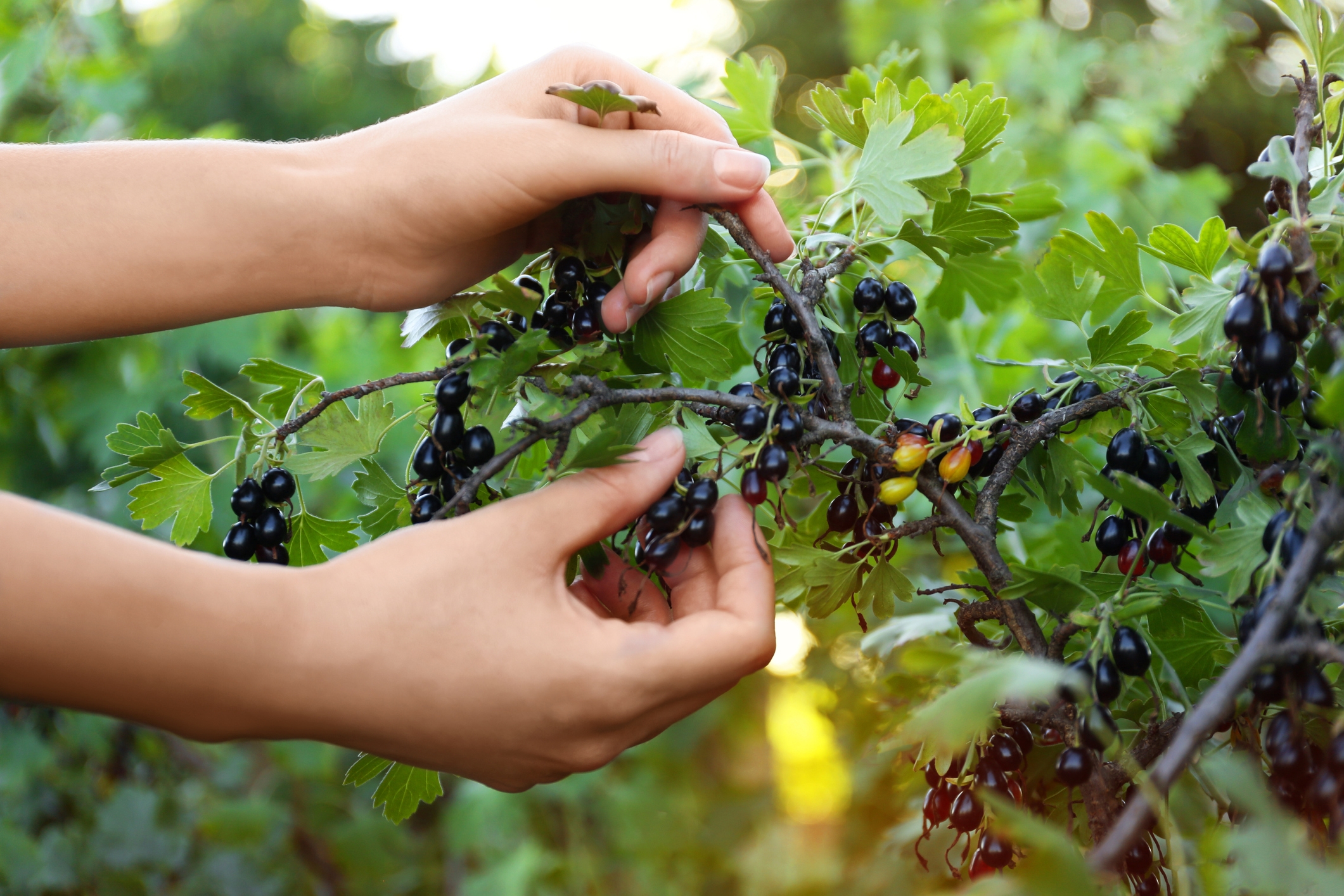Black Currant
Black currants are small, glossy, and dark-purple berries known for their tart flavour and rich nutrient profile. Native to northern Europe and Asia, these berries have been cultivated for centuries and are celebrated for their unique taste and health benefits. In Canada, including regions like Alberta, black currants have found a niche in both home gardens and commercial farms. Their adaptability to cooler climates makes them a valuable crop for northern regions.

More on Black Currant
About
The black currant bush is a hardy, deciduous shrub that can reach heights of up to 2 meters. The bushes produce clusters of these dark berries, typically in the mid-summer months. Each berry is about 1 cm in diameter and contains several seeds. The leaves of the black currant bush are also distinctive, being somewhat aromatic when crushed.
Nutritionally, black currants are powerhouses, boasting high levels of vitamin C, antioxidants, and anthocyanins. The latter are responsible for the deep purple colour of the berries and have been researched for their potential health benefits. Black currants also provide a good amount of dietary fibre, potassium, and other essential nutrients. Their unique combination of sweet, tart, and earthy flavours makes them stand out from other berries.
History
Black currants have been harvested from the wild for millennia, but their cultivation began in Europe in the 11th century. Over time, their popularity grew, especially in regions like Russia, Poland, and the UK, where they became a staple in many traditional dishes and drinks. In the 20th century, black currants faced a setback in North America. Due to their potential as a host for the white pine blister rust, which threatened the logging industry, their cultivation was restricted or banned in many parts of the U.S. and Canada. However, as resistant varieties were developed and the significance of the logging industry changed, these restrictions have been lifted in many areas.
Today, Alberta and other parts of Canada are seeing a resurgence in interest in black currants, both for their culinary versatility and health benefits.
Ways To Cook
Black currants are incredibly versatile in culinary applications. Fresh out of the bush, they can be a bit tart for some palates, but this characteristic makes them excellent for jams, jellies, and syrups. To prepare them, it's essential to rinse the berries gently and remove any stems or leaves. They can be eaten fresh, added to salads, or sprinkled over desserts. Black currants are also commonly used in baking, finding their way into muffins, pies, and tarts.
When cooked down with sugar, they form a rich, flavorful jam that pairs well with toast, scones, or yogurt. In beverages, black currant juice is both refreshing and nutritious, often diluted with water or sparkling water. The famous French liqueur, Crème de Cassis, is made from black currants and serves as a base for various cocktails.
For a more savoury application, black currant sauces can accompany meats like lamb or game, providing a sweet-tart counterbalance. Whether sweet or savoury, black currants bring a distinctive flavour that elevates any dish or drink.
Some Of Our Favourite Videos
Alberta Black Currant Producers
Hidden Valley Garden
About this producerFoods from this producer:
-
- Vegetables
Lettuce
-
- Vegetables
- Leafy Greens
Kale
-
- Vegetables
Chard
-
- Vegetables
- Roots and Tubers
Beet
-
- Vegetables
- Roots and Tubers
Carrots
-
- Vegetables
- Cabbage Family
Cabbage
-
- Vegetables
Green Bean
-
- Vegetables
Potatoes
-
- Vegetables
Pea
-
- Vegetables
- Roots and Tubers
Rutabaga
-
- Vegetables
Pumpkin
-
- Vegetables
Zucchini
-
- Herbs & Spices & Flavourings
- Culinary Herb
Dill
-
- Herbs & Spices & Flavourings
- Culinary Herb
Chives
-
- Fruit
Saskatoon Berry
-
- Fruit
Raspberry
-
- Fruit
Chokecherry
-
- Fruit
Black Currant
-
- Fruit
Rhubarb
Billyco Junction Gardens
About this producerFoods from this producer:
D & A Gardens
About this producerFoods from this producer:
The Berry Farm (at Christie's Corner)
About this producerSaskatoon Farm
About this producerFoods from this producer:
-
- Fruit
Saskatoon Berry
-
- Fruit
Black Currant
-
- Fruit
Apple
-
- Vegetables
- Roots and Tubers
Carrots
-
- Vegetables
- Roots and Tubers
Beet
-
- Vegetables
- Leafy Greens
Kale
-
- Fruit
Rhubarb
-
- Vegetables
Lettuce
-
- Vegetables
- Leafy Greens
Sorrel
-
- Vegetables
Potatoes
-
- Herbs & Spices & Flavourings
- Culinary Herb
Dill
-
- Vegetables
Onion
-
- Vegetables
- Cabbage Family
Cabbage
-
- Vegetables
Tomatoes
-
- Vegetables
Cucumber
-
- Fruit
Raspberry
-
Hidden Valley Garden
Hidden Valley Garden, 1271 Township Road 392, Red Deer County, AB, Canada
-
Billyco Junction Gardens
Billyco Junction Ltd., RR260, Lacombe, AB, Canada
-
D & A Gardens
DNA Gardens, Range Rd 230, Elnora, AB, Canada
-
The Berry Farm (at Christie's Corner)
52002 Range Road 232, Sherwood Park, AB T8B 1B3, Canada
-
Saskatoon Farm
The Saskatoon Farm, 338 Avenue East, Foothills County, AB, Canada
